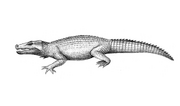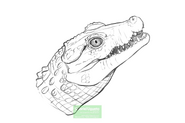Trilophosuchus ("Triple Crest Crocodile") is an extinct genus of mekosuchine crocodilian from Australia. Unlike living crocodilians, it is hypothesized to have been terrestrial. Trilophosuchus was approximately 1.5 metres (4.9 ft) in length. It had a short skull with three ridges on top and large eyes. Fossils have been found at Riversleigh in north-western Queensland, and are Miocene in age. Only a single species has been described, the type species T. rackhami.

Discovery[]
Trilophosuchus is known from a posterior portion of the skull, QM F16856, the holotype specimen. Several other isolated bones of the skull were found. The material was collected from the Ringtail Site of the Gag Plateau in Riversleigh, one of Australia's most famous fossil localities. The skull was uncovered in 1985 during an excavation by the University of New South Wales. The deposit in which Trilophosuchus were found are Early Miocene in age, roughly 20 million years old. The deposit, known as System C, is the youngest of the Oligocene-Miocene sequences at Riversleigh. The genus Trilophosuchus was erected in 1993 with the description of the remains by Paul Willis of the University of Sydney in the Journal of Vertebrate Paleontology.
Description[]
Trilophosuchus had a short, deep skull and relatively large eyes. Although only the skull is known, Trilophosuchus is estimated to have been around 1.5 metres (4.9 ft) in length. Because of its small size, Trilophosuchus resembles the living dwarf crocodile, Osteolaemus, and caiman, Paleosuchus. It also resembles earlier crocodyliforms such as the notosuchians, atoposaurids, and protosuchians. Being a mekosuchine, Trilophosuchus was not closely related to any of these forms and likely acquired a short snout and small body through evolutionary convergence.
In addition to its small size and short snout, Trilophosuchus has several unique characteristics, or autapomorphies, that distinguish it from other crocodylians. A posterior dentary tooth of the lower jaw passes between the sixth and seventh maxillary teeth of the upper jaw, leaving a deep groove in the maxilla. The palatal fenestrae, two openings in the palate, reach up to the level of the sixth maxillary teeth. The palatine bone has an anterior process, or projection, that reaches to the level of the fourth maxillary teeth. Behind the palatine and the palatal fenestra, there are large pterygoids and ectopterygoids that project posteriorly and extend below the skull. The jugal bones, which line the side of the skull below the eyes, project laterally to form prominent ridges. The supratemporal fenestrae, two holes on the skull table, are long and narrow. There are also three ridges running longitudinally on the skull table, giving the genus its name, which means "triple-crested crocodile" in Greek.
The occipital or posterior surface of the skull has structures for the insertion of muscles that would have held the head above the body.

